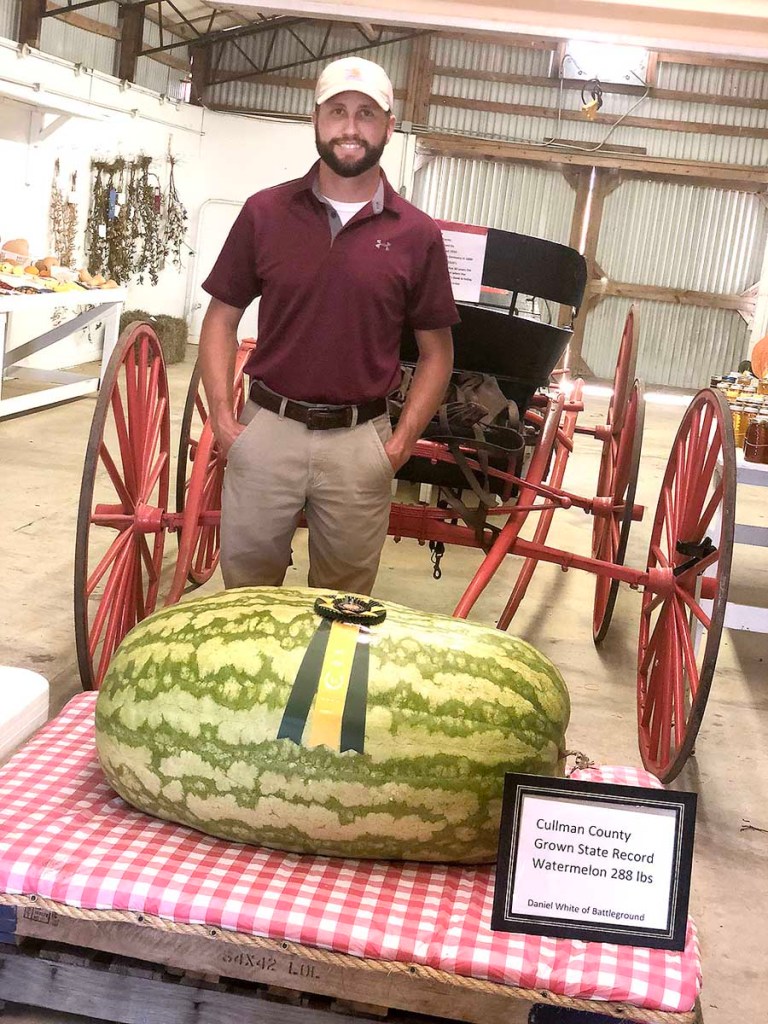Watermelon man: Battleground resident takes melons to new weights
Published 5:30 am Saturday, October 6, 2018

- Battleground’s Daniel White is seen with his prize-winning watermelon Thursday at the Cullman County Fair.
Lauren Estes-Velez
Special to the Times
Trending
Cullman County native Daniel White has always been interested in watching things grow.
This year, he produced two monstrous watermelons, the first one weighing in at 255 pounds in Guston, Kentucky. Two weeks ago he had a 288-pound melon in Bear Wallow, Kentucky
“The whole process from seed to harvest has always caught my interest,” White said. “I’ve been growing something every year since I was about 10-years-old. It started off with some gourds, tomatoes, beans and I’ve added a little more each year. I actually did some truck farming from 2013 to 2016 and sold vegetables at the local farmers market. With a fulltime public job, maintaining cattle and trying to grow giant watermelons, I just didn’t have time to keep the truck farming going. I would like to get back to it someday.”
White is a West Point High School and Wallace State Community College graduate and lives in Battleground near the Cullman County/Morgan County line.
“I raise a few cows and I used to fish a lot as a hobby, but once I got bit by the giant watermelon bug, fishing kinda took second place even though I still try to wet a line every chance I get,” White said.
After watching White’s great aunt and uncle grow these gigantic watermelons and enter them into the Cullman County fair, he eventually wanted to grow one of his own.
Trending
“The biggest they ever raised was around 110 pounds and when your 7- to 8-years-old, a melon that size looks as big as a pickup truck,” White said. “I never thought much about growing them myself until 2013. My great-uncle had already past away then, so I had no idea what kind of watermelons they used to grow. I googled ‘giant watermelons’ and found Mr. Loyd Bright in Arkansas. His family has been raising the giant watermelons since probably the 1950s. I ordered some seeds from Loyd and grew the first giants from those seed. I had a 105-pound melon that first season.”
During the 2013 Farm Y’all Festival, White decided to enter his 105-pound melon in the “giant watermelon weigh off,’ which quickly started something in his life he didn’t see coming: a hobby and passion.
“The melon didn’t place very high, but I got the chance to meet growers from all over the country at that event,” White said. “Mr. Frank Mudd from Kentucky brought a 276-pound melon I believe it was, to the Farm Y’all festival that first year. As soon as I saw them unload that big ol’ watermelon, I knew there was much more I wanted to learn about these plants that can produce fruit like that. Mr. Mudd has been super helpful ever since then, from sending me some of his watermelon seeds to grow, to giving advice on the multiple issues giant melon growers face from pollination time to harvest.”
Per competitions, he has won the Cullman County Fair 3 to 4 years and this past weekend’s GPC sanctioned weigh-off (in Bear Wallow, Kentucky) was the first big-time weigh-off that he was given the grand prize.
“Some of the best growers in the world enter watermelons at the GPC events that are scattered around Tennessee, Kentucky, North Carolina and Ohio,” White said. “It’s really fun to go to these events and talk with fellow growers and exchange ideas. I broke the state record in 2015 with a 243 pound watermelon. That record was broke by a couple growers in the following years and then my 288-pound set a new record this year.”
What’s up next for White? Preparation for the 2019 growing season and all things that come with it.
“Watermelon season is almost over, so the next task will be picking up all the walk boards, melon huts that I use for sun protection, fencing and getting the soil read to go for 2019 will begin. I’ll send soil samples off to Auburn and see what amendments I need. When I get the soil report back, I’ll add the needed amendments and plant a cover crop of something like mustard greens, turnip greens and vetch. The cover crop grows through the winter and then is cut down and tilled under in the spring.”






